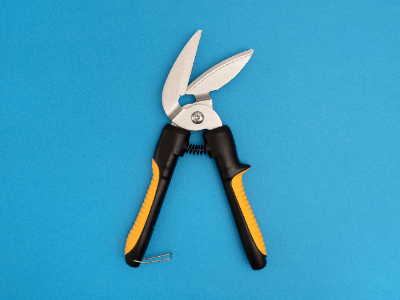What Is All-Purpose Scissors?

All-purpose scissors are scissors that can be used for all purposes.
They can cut a variety of things, including metal, foodstuffs, and thick cardboard. General scissors are designed for cutting paper, cloth, etc., so they must be used for specific purposes.
All-purpose scissors, on the other hand, have the advantage that they can cut a very wide range of materials, eliminating the need to use multiple pairs of scissors. Any material can be used without changing scissors, and there is a way to keep them in the kitchen for cooking. Since they are a frequently used and easy-to-use item, each household now has one of these commodities.
Uses of All-Purpose Scissors
All-purpose scissors can be used in eight different ways: as scissors, knives, skin peelers, scales removers, bone cutters, shell crackers, can openers, and bottle openers. The appeal of all-purpose Scissors is that they can be used for everything from hard objects such as metal sheets and plastics to thick objects such as carpets, in addition to paper and thread.
They are very useful not only for DIY but also for cleaning, such as making gardening braces and thinning what would otherwise be bulky trash. Some of them can even be used to tighten fish caught during fishing.
In addition to their function as scissors, many of them also have a bottle opener and can opener.
Principle of All-Purpose Scissors
All-purpose scissors have a simple structure with two blades connected by a shaft. The mechanism uses the principle of leverage to create a large shearing force.
In the case of ordinary scissors, the part where the fingers are inserted (handle) is called the “force point,” the part where the blades overlap (shaft) is called the “fulcrum,” and the part where the blades apply force to paper, etc. is called the “action point. The shorter the distance between the blade (point of action) and the shaft (fulcrum), the greater the shearing force, and the longer the distance, the smaller the shearing force.
All-purpose scissors can cut tough materials such as metal wire by the leverage principle, but there is another important mechanism. In addition to the “Urasuki,” which is an indentation on the inside of the blade, there is also a “Sori,” which is curved from the base of the blade to the tip of the blade.
This mechanism allows the blade to strike only one point when cutting, creating a large amount of force. All-purpose scissors have several mechanisms that improve sharpness, turning a small force into a large force, and allowing you to work more efficiently.
How to Choose All-Purpose Scissors
When choosing all-purpose scissors, you need to check the following 6 points
1. Handle Material
The material of the handle has a great influence on how comfortable the handle is to grip. While most handles are made of resin, some are made of low-resilience material, which provides a good cushioning and gripping force.
When purchasing all-purpose scissors for long hours of work, this is the material you should give priority to. In addition, there are a variety of other products available, including rubber materials, so we recommend that you touch them at a store and choose the one that suits you best.
2. Handle Shape
Since the condition after cutting varies depending on the ease of force and grip, it is important to check whether the shape of the handle is suitable for you by actually cutting. The handle shape of all-purpose scissors can be symmetrical or asymmetrical in size, oval or circular, etc.
- Asymmetrical Type: All-purpose
- Circular Symmetrical Type: For fine work
- Oval Symmetrical: For heavy-duty work
- Pliers Type: For cutting metal materials.
3. Blade Shape
The shape of the blade to be selected depends on the material to be cut and how it is to be cut. It is important to understand the characteristics of each blade and select the one that best suits the purpose of use.
- Straight Blade
When accuracy is required, such as when cutting in a straight line - Curved Blade
For cutting even with light force, when working for long periods - Saw Blade
For cutting slippery materials because the finely lined blades bite into the object.
4. Blade Material
Stainless steel is recommended. On the other hand, if you are a frequent user of all-purpose scissors, carbon steel with high strength and good blade durability is the best choice.
5. For Right-Handed and Left-Handed Users
Like kitchen knives, scissors are available in right-handed and left-handed versions. When held by the dominant hand, scissors are held with the blade with the handle on the thumb side open downward, making it easier to see the part to be cut.
However, if you use a type of scissors that does not fit your dominant hand, not only will it be difficult to see the part to be cut, but the blade engagement will be weakened by using the scissors in the opposite direction.
As with general scissors, it is important to select all-purpose scissors of a type that suits your dominant hand.
6. Accessory Functions
If the scissors have a can opener or bottle opener, you can use them for cooking. All-purpose scissors, which are usually used as tools, can also be used for outdoor activities.
If you are particular about multifunctionality, it is a good idea to check the attached functions while imagining in what situations you can make use of them.